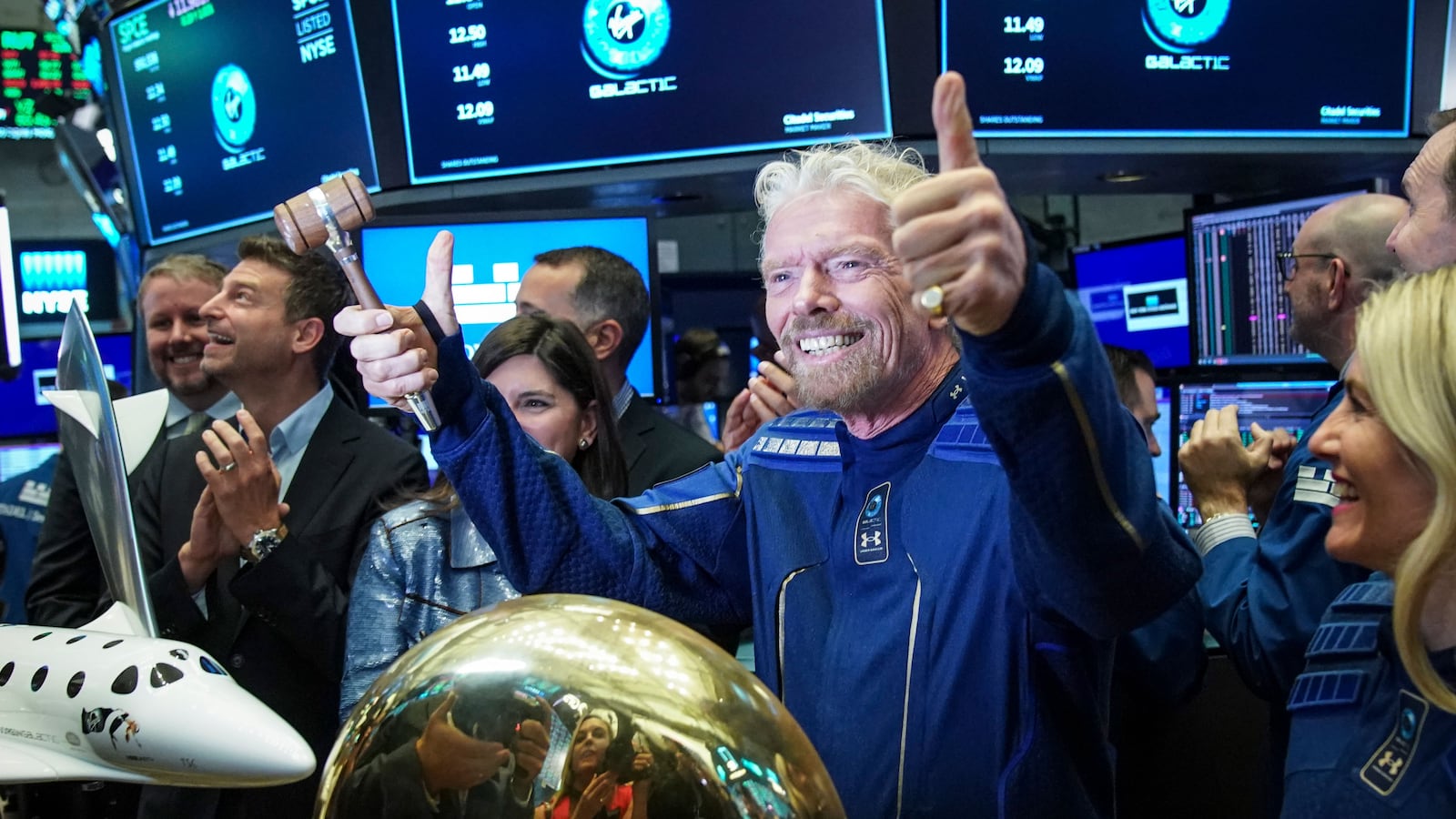Competition with Jeff Bezos has forced 70-year-old Richard Branson to rediscover his inner daredevil, the Branson of more than 20 years ago who attempted to circumnavigate the globe in a hot air balloon, much to the alarm of his family.
The two moguls are now locked in serious combat over who will be the first to be shot into suborbital space aboard vehicles of their own devising, thereby initiating space tourism. Bezos has set July 20 for his own lift-off. Now Branson is shooting for July 11.
Branson made his decision after Bezos announced that, along with himself and his brother, he had invited 82-year-old Wally Funk, the only woman to train for NASA’s Mercury astronaut program but who never made it into space, to join him aboard his Blue Origin rocket.
Clearly, this pushed the mano a mano contest to a new level of provocation that Branson, always a consummate carnival barker, was unable to ignore. His original plan was to wait for his Virgin Galactic ship, VSS Unity, to make at least one more test flight before he stepped aboard. (Branson claims that his decision has nothing to do with Bezos, telling Good Morning America, “I know that it’s been painted as a race, honestly I don’t think either of us see it that way.”
And, make no mistake, Branson is, by far, taking the bigger personal risk in this game.
What makes his decision seem impulsive and even dangerous is that Unity is still far short of becoming the kind of thoroughly tested and reliable vehicle that would be able to fly passengers on a regular schedule.
Crucially, it has never flown as he is now proposing it should do, with a full complement of six passengers and two pilots. (It has flown once with a third person, a flight instructor.) That’s when the craft will reach its critical limits: at full rocket power and aiming to reach an apogee of around 60 miles above the earth, and moving at more than three times the speed of sound.
Since it first flew in 2016, Unity has flown only three test flights under rocket power, two from Galactic’s test center in the Mojave Desert, California, and one from Spaceport America, New Mexico, where paying passenger-carrying flights are set to begin next year.
That contrasts with the testing of Bezos’s Blue Origin rocket. It has completed 15 flawless test flights and met ambitious targets, including the use of reusable booster rockets.
Nevertheless, these are very different concepts, a contest between what could be called brute force (Bezos) and complicated elegance (Branson).
Blue Origin is basically a conventional rocket with a passenger capsule on top of it that floats back to earth under parachutes when the rocket is expended. Galactic uses a mother ship to lift Unity to around 50,000 feet, where it is dropped and then fires up its rocket. As it falls from apogee, Unity uses a unique shuttlecock-like action to flip, on re-entry, from high-speed flight to glide back to a landing. A Blue Origin flight lasts between 10 and 11 minutes. Galactic, including the mother ship flight, lasts around 90 minutes.
Branson has, typically, been trumpeting that the FAA has just given Galactic certification to fly paying passengers. Not so. Galactic is flying under a commercial reusable spacecraft operator’s license for a vehicle that is still regarded as experimental. Under the terms of this license, the company needs to complete two more “verification reports” before being cleared to fly paying passengers.
The test flight that Branson has now bumped in order to take his own flight was expected to deliver one of those reports. By moving to a flight with full passenger and crew loading the challenge to meet those marks is suddenly much greater.
FAA regulators can only learn what is safe and what is not as the test pilots learn it themselves. Their final certification is based on the successful completion of the testing. Galactic’s test flights have been very infrequent, as each flight explored the limits of the envelope and exposed new problems.
Unity’s last flight demonstrates how carefully this process has to evolve. It was testing significant changes to the flight control system and new software. Vital questions remain about whether the rocket engine can deliver enough power for the craft to reach apogee when fully loaded. That’s a problem Bezos does not have because he uses a giant booster. Unity’s rocket is limited in size—and therefore in power—by being enclosed in a sleek airframe.
The most important thing in assessing risk—including the risk that Branson is now taking himself—is to resist the impression of space tourism being safe because the FAA issues the license to fly.
This kind of travel will never be able to meet the same safety standards applied to commercial airline travel. The test program for a new airliner involves between four and six jets, each testing different systems, and lasts for at least two years. Thousands of flights are needed before the FAA certifies them as safe for passengers. Even then, you can get a failure to catch flaws like the one that led to two catastrophic crashes of the Boeing 737MAX.
The jets used in testing rarely move on to fly with an airline; they remain to be used for the research and development of new systems and engines. And yet Branson intends to move Unity, as yet Galactic’s only vehicle in the air, directly from testing to carrying paying passengers.
His stated goal of making 400 pre-sold flights a year is, in reality, years away. To do that, Galactic is planning a new generation of far more advanced design, known as Spaceship Delta. But Branson has decided that, with Bezos able already to demonstrate a far faster frequency of flights, he needs to demonstrate the nerve and audacity that has kept his faith in Galactic aloft for 16 years—no matter what the risk.

